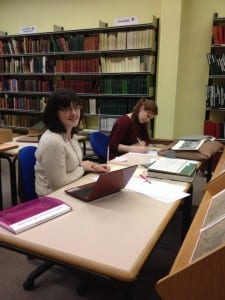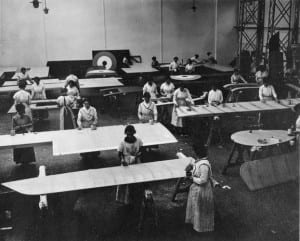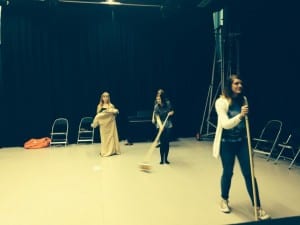We reach that point in production where the devising has just begun, the research has been collated and the directing team are putting in place all the big, small, important and on some occasions ridiculous ideas that will be sewn together to create ‘Sincerely Yours’. As a director, it is important to remember as many of the ideas and research materials that we have collected over the past month and a half; all the playing and experimenting and now start cherry picking the best of it all to create our performance.

(Charlotte Mooney, 2014)
We are working currently on our “big scene”, otherwise known as ‘The Factory Scene’. The scene is set in a cotton mill in Lincolnshire (keeping it local!) where the women are working the home front while the boys are away at war. They are a representation of the British war machine; sewing plane wings, making stretches of material for further development and any cotton based resource that would be needed for the war effort. As the dance director, I took inspiration from the stories and history we have learned over the past couple of months from the archives, the care homes, the family stories and history books that it was the professional nature of the women working like machines back home to “keep the home fires burning”. Therefore, I chose to show this machine like system of women in the factories through a combination of dance, physical theatre and tightly choreographed movement to create an industrial appearance.
(Imperial War Museum, Accessed on March 14th 2014)
The whole scene is uniformed, precise and powerful to show how professional and hard working the women were in their positions back home. The scene includes tap dancing to create the sounds of the war machine and the factory itself; to give the piece pace and rhythm, and as the demand for materials increases the pace has the ability to increase, thus creating a sense of chaos. I have included a devised broom/sweeping routine in this scene as well, to show the domesticity of the women and how they kept a clean environment within which to work; vital when in the cotton mills especially. The different noises made by the brooms based on which part of the broom you use creates a completely different tone to the piece; the sweep, the hard knocks, the slides all add layers to the rhythm of the home war machine.
(Louise Pearson, March 2014)
Then I move onto the inclusion of the cotton sheets themselves, creating patterns and shapes to add creativity and fun into a scene that would otherwise be very simple. What I love about this scene is it’s universal nature; it could be any type of factory, anywhere in England, any war but the focus on how the women worked so professionally, and how they responded to increase in demand or any personal issues did not hinder their work. The women of the WW1 cotton mills were machines, were providers, were the solidarity of the home front war effort and we should be proud of our heritage.
Works Cited
Charlotte Mooney, March 2014.
Imperial War Museum, accessed on http://www.iwm.org.uk/collections/item/object/205195286 on 14th March 2014.
Louise Pearson, March 2014.

